East Germany 1989 - the march that KO'd communism
- Published
Leipzig 1989: East Germans defy communist rule with huge demo
Nobody had a mobile phone or social media to mobilise supporters back in 1989.
But East Germans fed up with communism poured into the streets of Leipzig, despite extraordinary restrictions on their personal freedom.
"We didn't have a phone at home - we weren't allowed, and they would have been listening in any case," recalls Katrin Hattenhauer, one of the organisers of the Monday demonstrations in Leipzig, East Germany's second city.
A candle-lit mass protest on 9 October became the turning point: a crowd of 70,000 thronged the city centre and for the first time dared to march past the feared headquarters of the Stasi secret police. "We are the people!" they chanted. "Wir sind das Volk!"
About 6,000 armed police and plain-clothes Stasi were watching in the side-streets - but they held back, vastly outnumbered.
The grip of communist propaganda on people's behaviour had been broken. But East and West Germans alike were astonished by the fall of the Berlin Wall just a month later.
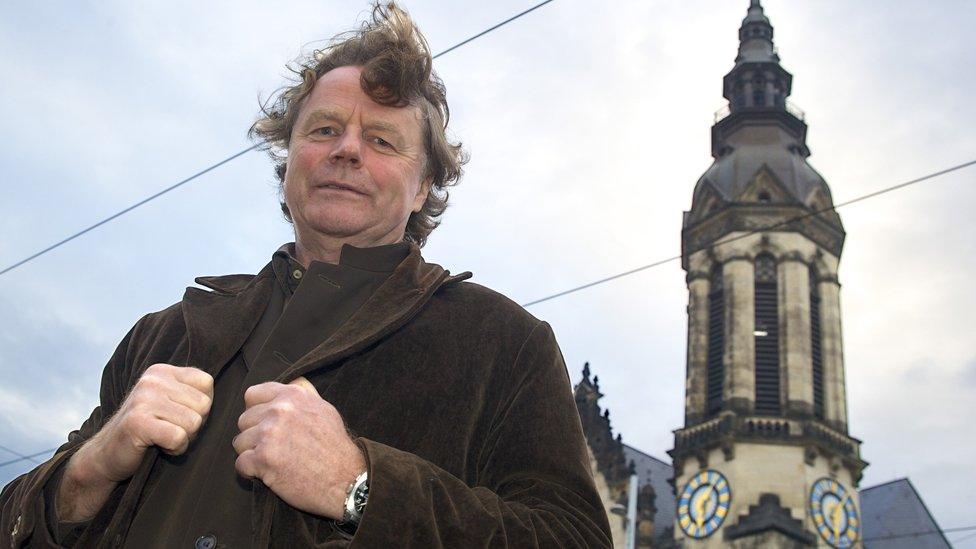
Siegbert Schefke in 2014: The church tower in the background was his vantage point for filming the 9 October 1989 protest
What triggered the peaceful uprising?
There was already widespread frustration and anger in East Germany - officially the German Democratic Republic (GDR) - and that mood escalated throughout 1989.
Millions of East Germans secretly watched colourful, capitalist West German TV, even though that was illegal. They saw the West's luxuries and plentiful consumer goods, but had little chance of going there. Meanwhile the communist GDR was grey, regimented and plagued by shortages.
Regime opponents were spied on and harassed by the Stasi, who often blocked people's study and career choices.
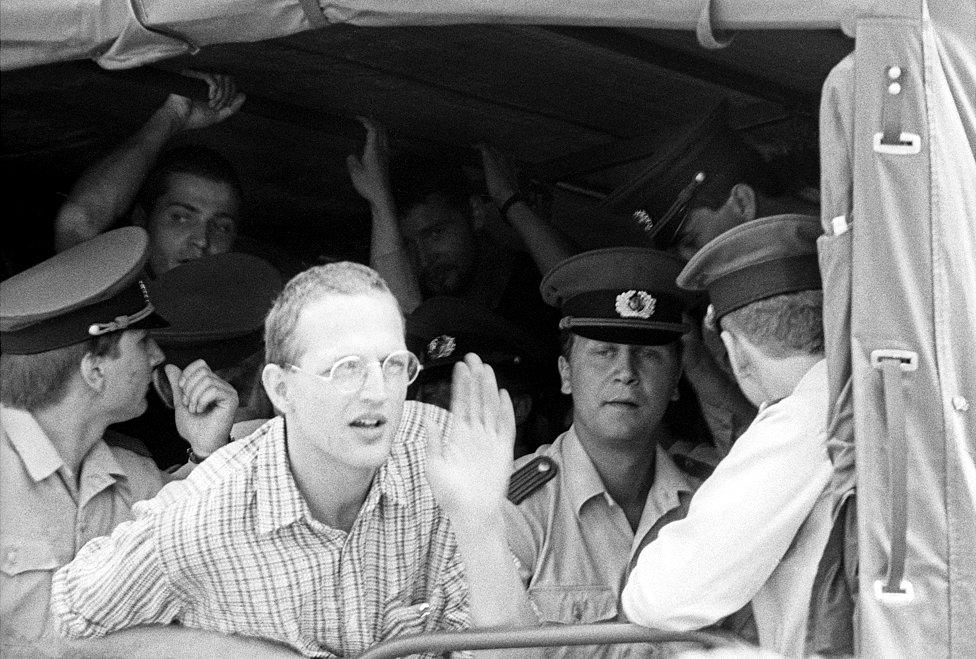
Organisers of a street festival in Leipzig were arrested in June 1989
Ailing 77-year-old communist leader Erich Honecker was resisting reforms, while neighbouring Poland and Hungary were both going through democratic transitions.
Their "big brother" - the Soviet Union - was led by reformer Mikhail Gorbachev. His "glasnost" (openness) policy, encouraged by the West, allowed dissent and forced Soviet citizens to confront long-hidden communist crimes.
"Gorbi, Gorbi!" became a popular slogan among East Germans hungry for Gorbachev-style reforms.
In the summer of 1989 Hungary removed barbed wire on its border with capitalist Austria, creating an escape route for East Germans desperate to reach the West. Many East Germans traditionally went on holiday to Hungary, deprived of other opportunities for foreign travel.
The exodus became a human flood; thousands also sought refuge in the West German embassy in Czechoslovakia, and families became separated.
Mr Gorbachev visited East Berlin for the GDR's 40th anniversary on 7 October and urged Mr Honecker to launch reforms, saying "life punishes those who come too late".
The GDR claimed to have freed "the people" from capitalist exploitation: building communism meant job security, cheap housing and collective welfare.
Why was Leipzig key to the GDR's collapse?
For several years Pastor Christoph Wonneberger had led "peace prayers" every Monday at the Protestant Nikolaikirche - St Nicholas Church, which became a safe space for political dissidents.
The 1980s were years of protest against the siting of nuclear missiles in Europe. The US missiles in Western Europe drew the biggest protests; but Mr Honecker also tolerated the small East German peace movement's opposition to Soviet nuclear missiles in the GDR.
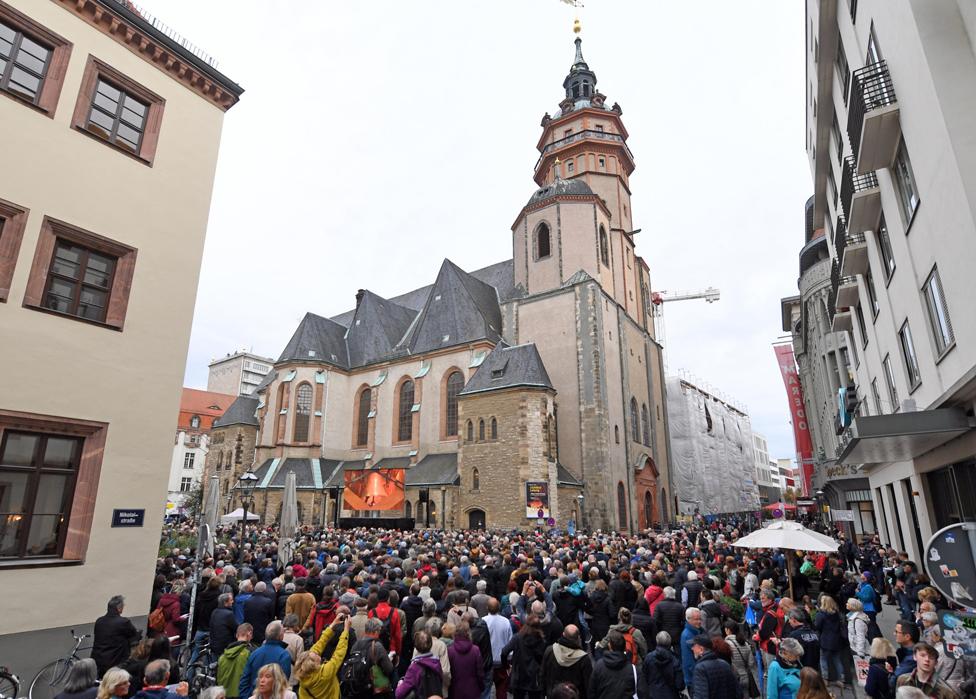
Leipzig 30 years on: Commemoration at St Nicholas Church marking the 1989 mass protest
"The Nikolaikirche was known in Leipzig as a free place. We knew the Stasi was in the church, but our activities couldn't be forbidden, because they were called peace prayers, not a protest," says Ms Hattenhauer, who was 20 at the time.
"Group solidarity was getting stronger and the summer of fleeing helped us a lot. Many people joined as they were desperate, having lost family members. So people were looking for a place to share their stories, to decide how life now should go on," she told the BBC.
Leipzig's international fair on 4 September provided a rare opportunity for the anti-communist opposition: Western journalists were allowed into the city.
Ms Hattenhauer and fellow dissidents changed their strategy for 4 September. "We had to lead people out of the church, to become visible, to give the movement a face."
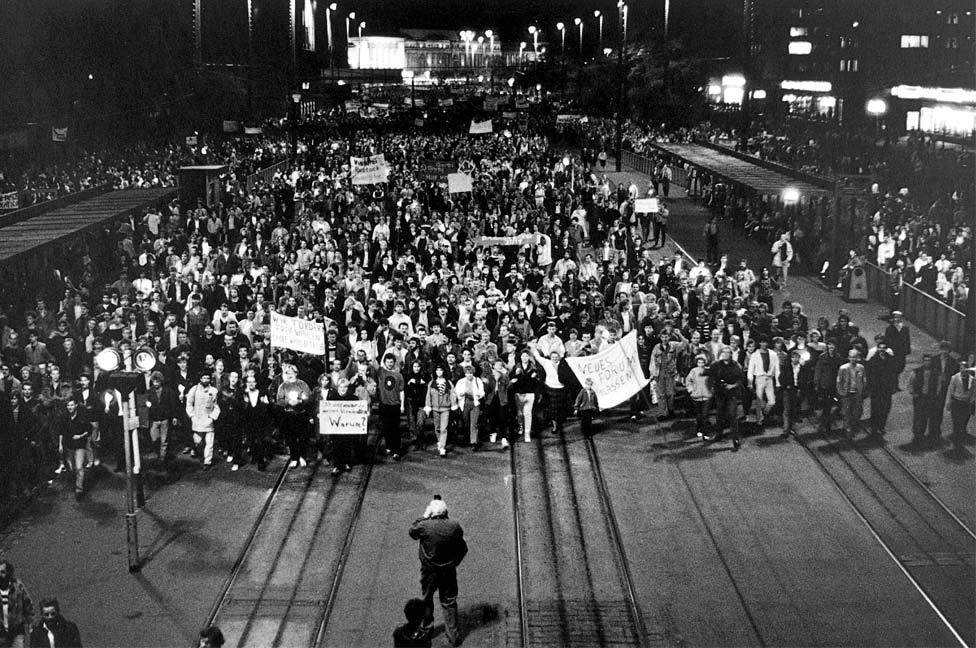
The march that passed Stasi HQ and proved a tipping point - Leipzig 9 October 1989
They unfurled banners with the slogans "freedom to assemble" and "for an open country with free people". Immediately the Stasi snatched them away - but crucially the state's brutality was filmed by West German TV.
Watching those pictures, East Germans "could see that the government's lies about us were not true - we didn't look like counter-revolutionary criminals", she said.
Ex-dissident Uwe Schwabe told the BBC "people were so fed up with the GDR, constantly living with lies and propaganda". "The reality was that Leipzig was in a terrible polluted state, the air was awful, it stank."
He had long campaigned to clean up the GDR's environment. Leipzig's main pollution problem was nearby brown coal (lignite) mines.
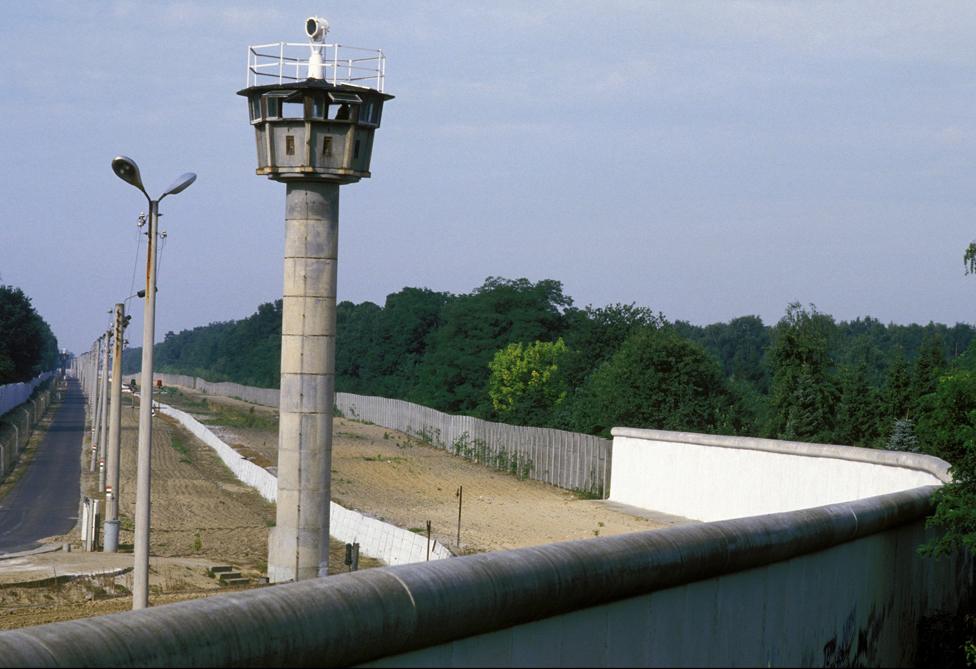
The Berlin Wall in 1986: Communist East Germany branded those who fled to the West as criminals
Why was 9 October a turning point in the protests?
By October 1989 there were many diverse opposition groups and, according to ex-dissident Kathrin Mahler Walther, Pastor Wonneberger was a key coordinator.
"Many people decided they couldn't be free journalists or lawyers [in the GDR], so they studied theology to be free of the state, and there were critics among them," Mr Schwabe said.
Yet activist priests were a small minority in Leipzig's Protestant Church - just six out of 50, Mr Schwabe said. And the Catholic Church shunned the activists.

The fall of East Germany in 1989
August-September: Thousands of East Germans flee to the West across Hungary's border with Austria; others flee via Czechoslovakia
9 October: Unprecedented crowd of 70,000 demonstrates in central Leipzig demanding freedom
18 October: Communist leader Erich Honecker quits, replaced by Egon Krenz
7 November: Government and Politburo resign
9 November: Fall of the Berlin Wall
3 October 1990: German reunification

Pastor Wonneberger, Ms Walther and other activists created a network in Leipzig, enabling the 9 October demonstration to have a huge impact.
The publicity already created by the Monday demonstrations "made the time ripe", Ms Walther said. "Everyone realised: 'Wow, something is really changing here.'"
But many protesters feared that the police would open fire, as the communist Chinese crackdown in Tiananmen Square was still a fresh memory. A senior GDR Politburo member, Egon Krenz, had praised that crackdown.
Fall of Berlin Wall "was worst night of my life" - Egon Krenz
So the crowd in Leipzig also chanted "No violence!" and activists urged fellow protesters to avoid giving the police any excuse to open fire.
"There were people of all ages in the streets, though a lot of older people tried to stop their children going," Mr Schwabe said.
It emerged later the authorities had ordered Leipzig hospitals to prepare extra beds and blood supplies.
That night, Ms Walther phoned Pastor Wonneberger from a hiding place in the city's Protestant Reformed Church and reported to him on the demonstration.
He was in another church, also getting calls from other activists. Then he did a live interview by phone on West German TV news.
"Via West German TV we could speak to the GDR people," Ms Walther explained.
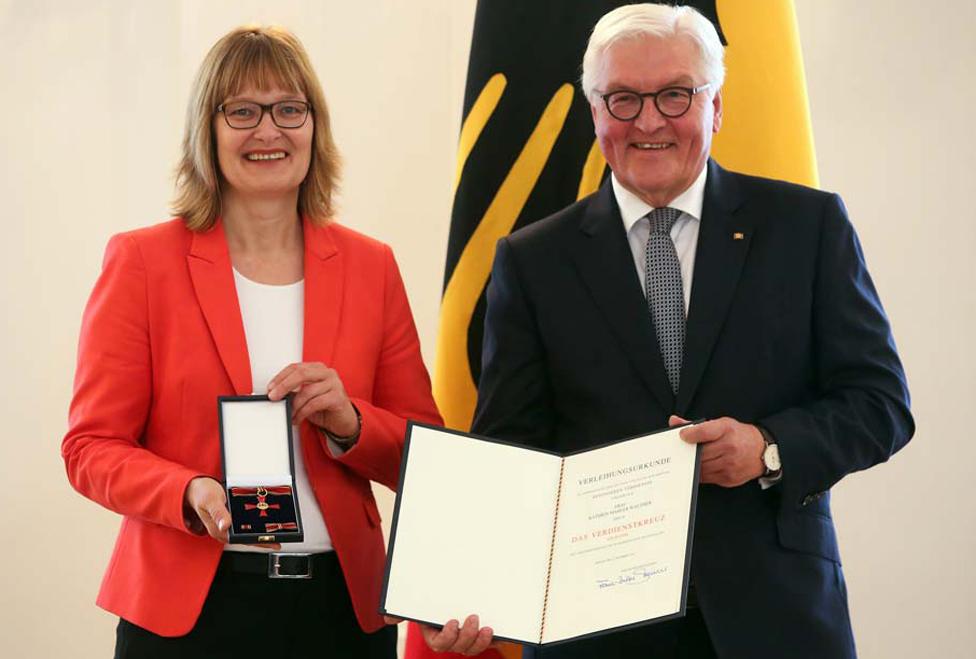
Ex-dissident Kathrin Mahler Walther was awarded Germany's Federal Order of Merit this month
Two more activists - Aram Radomski and Siegbert Schefke - had a TV camera, but needed a safe place to film the demonstration. Ms Walther put them in touch with the pastor, who let them climb up the Reformed Church's tower.
"I didn't dare film it at street level," Mr Schefke, an East Berlin dissident in 1989, told the BBC.
"Later I met the [West German] Spiegel reporter, Ulrich Schwarz, in a hotel and gave him my recording, which he took back that night."
The peaceful uprising of 70,000 people was broadcast on West German TV the next day.
The protest movement was unstoppable: a week later more than 100,000 thronged central Leipzig and protests soon spread across East Germany.
"I am 60 years old now. I was living behind barbed wire, but now I've spent longer in freedom than without it. I was walled in for 30 years," Mr Schefke said.
- Published10 October 2019
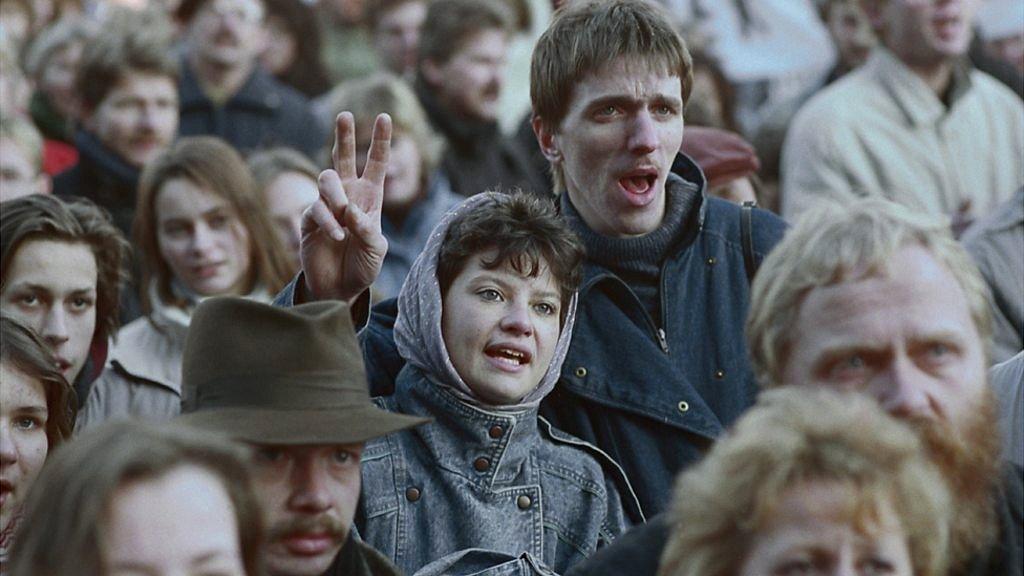
- Published10 October 2019
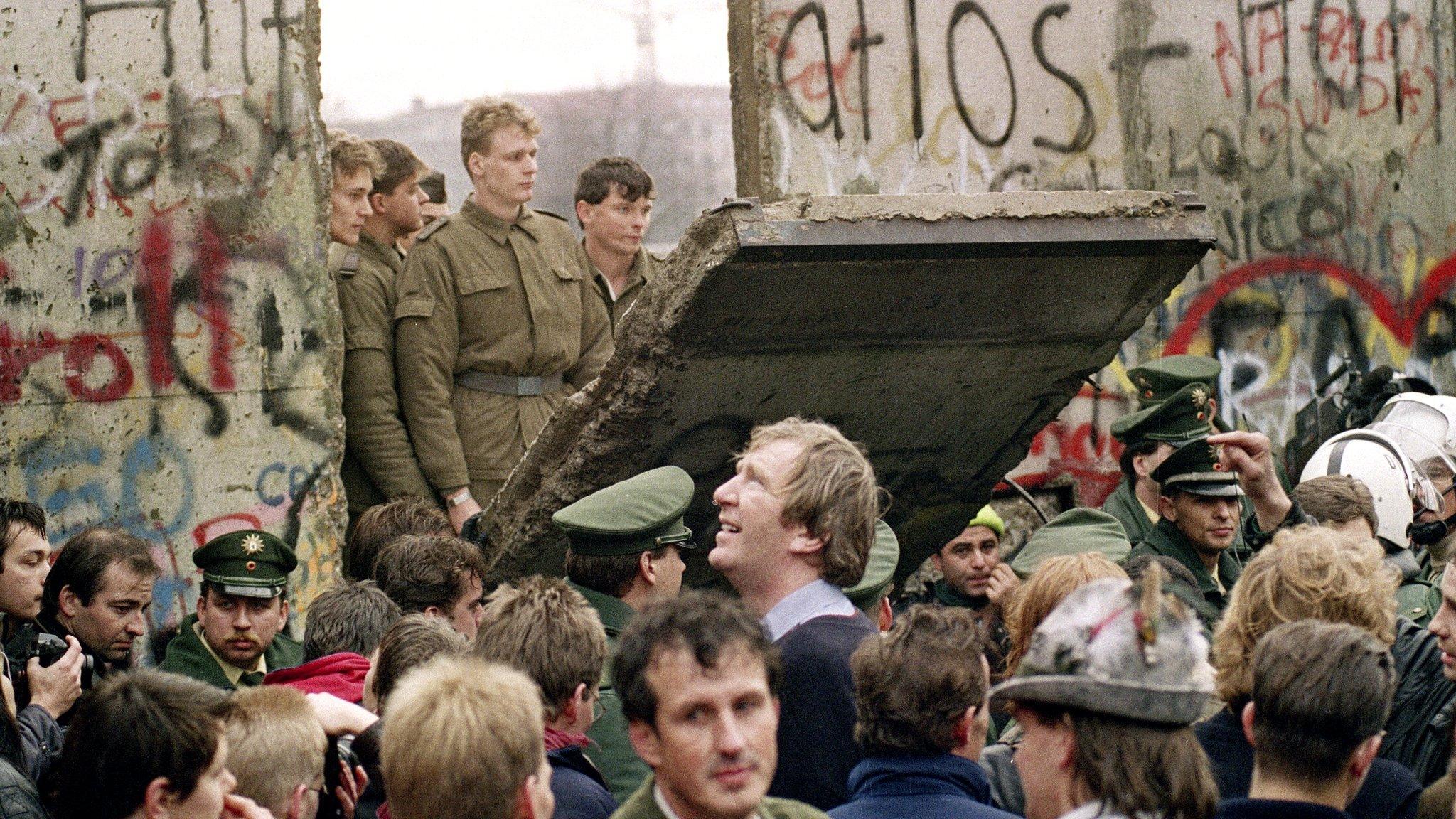
- Published19 August 2019
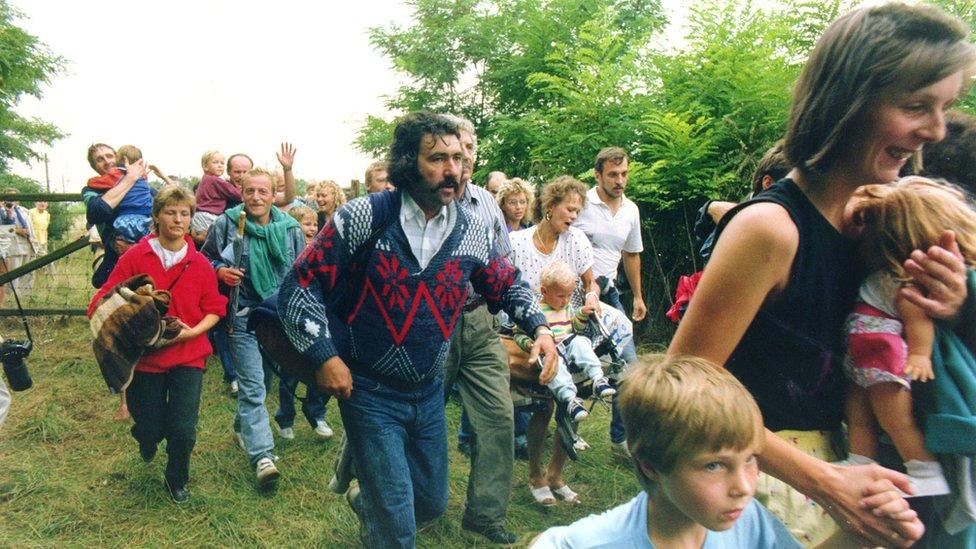
- Published27 September 2019
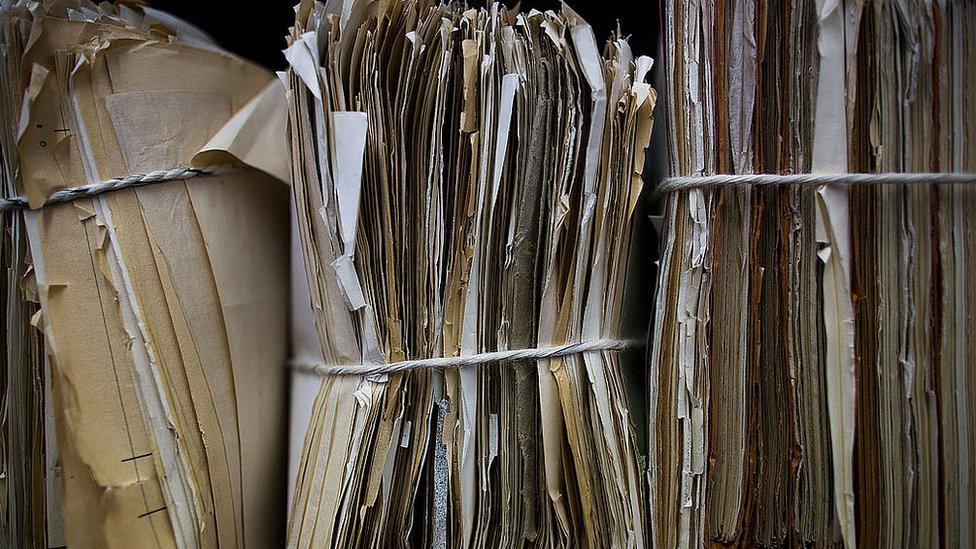
- Published6 September 2013
- Published8 June 2017

- Published14 September 2012
